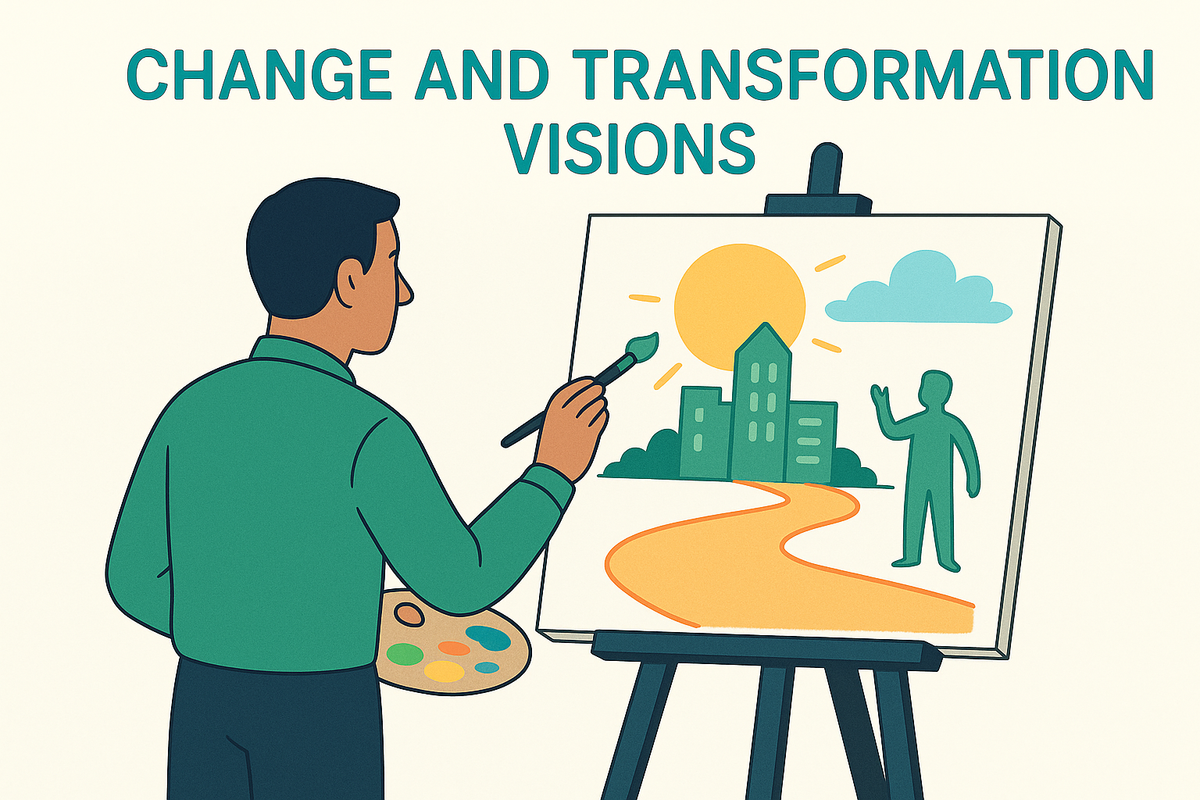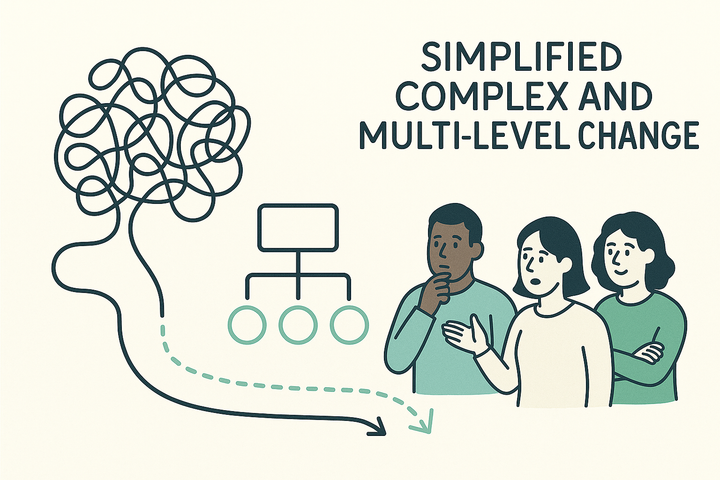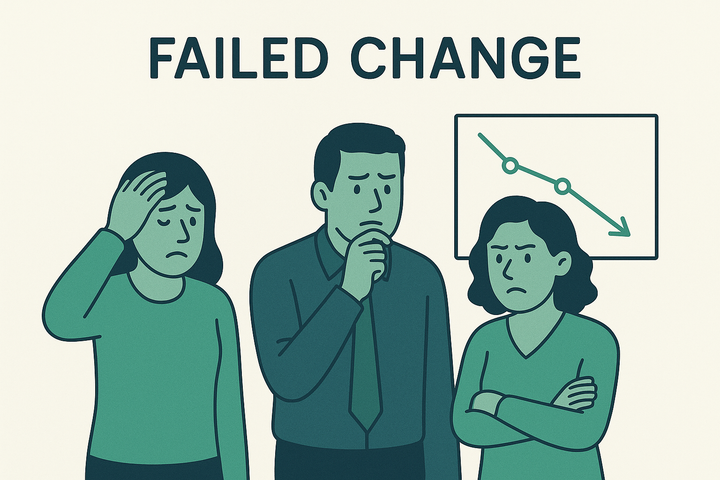Change and Transformation Visions – Painting the Future State
A well-crafted vision isn't a slogan. It's a tool to lead, align and energise your organisation through change. Here's how to paint the future state so people can move towards it with confidence.

People can’t move towards fog
One of the most important — and most overlooked — elements of change communication is a clear, credible and compelling vision.
Not a purpose statement. Not a slogan. Not a vague brand promise.
But an actual picture of what the organisation will look and feel like after the change has landed.
When people say “we need a vision,” they often end up with wordy slides or abstract ideals. But what your teams actually need is a future state they can see, understand, and imagine themselves in.
That’s how people move forward — not just because the old way is being shut down, but because they know what they’re moving towards.
What is a vision in change or transformation?
A change vision is a shared picture of what success looks like when the change has taken root. It’s a snapshot of the future state — specific enough to give direction, compelling enough to build belief, and clear enough to activate action.
It’s not your mission. That’s why you exist.
It’s not your strategy. That’s how you’ll get there.
And it’s not your values. That’s how you’ll behave on the journey.
A strong vision answers three key questions:
- What will be different when the change lands?
- Why does that future matter?
- What might people see, feel, and experience along the way?
It connects hearts and heads. It builds momentum. And it keeps people oriented when everything else is shifting.
Why the vision matters
The vision is the point on the horizon that your whole organisation is walking towards. Without it, change becomes directionless. Unanchored. Fatiguing.
Here’s what a strong vision gives you:
Direction
It helps leaders prioritise, project teams align, and staff understand how their work connects to the bigger picture.
Belief
It builds emotional connection to the purpose behind the change. People want to know it’s worth the effort.
Coherence
It anchors your messaging, behaviours and decisions. When every part of the system reflects the same story, trust grows.
Confidence
It gives people something solid to hold on to — especially when the details of delivery are still unfolding.
Agency
It allows people to ask: how do I contribute to this? What’s my role in bringing this future to life?
You might also like:
- Creating a Change Narrative
- Using Metaphors in Change Narratives
- The Art of the Backstitch – Why You Need to Return and Return Again to Your Narrative
- Change and Transformation Visions – Painting the Future State
- The Four Types of Organisational Change and How to Communicate Them
What makes a change vision credible?
A vision only works if people believe it. That belief comes from five things:
Clarity
If it takes a full slide or a page of bullet points to explain it, it’s too vague. Your vision should be simple enough to remember and real enough to repeat.
Tangibility
Make it practical. What will people see, say or do differently in the future state? What will a team meeting feel like? What will clients notice?
Realism
Stretch is good. Fantasy is not. Don’t pretend the future will be frictionless. Acknowledge the trade-offs and effort required to get there.
Consistency
Your vision should align with other organisational messages — not contradict them. If the future state described in your transformation conflicts with existing strategies, you’ll lose credibility fast.
Leadership embodiment
It’s not enough to talk about the vision. Leaders have to live it. Use it to guide decisions. Return to it often. Model it in their behaviour.
How to paint the future state
If your vision doesn’t feel alive yet, here’s how to bring it into focus.
Use this framing prompt:
It’s 12–18 months from now. The change has landed. You’ve made real progress. What do people see, hear, say, feel and do differently?
Get specific. Imagine:
- A day in the life of someone in the organisation
- A team meeting happening in the new context
- A leadership update describing progress
- A conversation with a customer or service user
Zoom out and zoom in:
- Zoom out: What’s changed at the system or strategic level?
- Zoom in: What’s different in the way teams work day to day?
Make it testable:
- What metrics or signals will show you the vision is being realised?
- What behaviours or outcomes would be different in a meaningful way?
Keep it real:
Use everyday language. Drop the jargon. If it wouldn’t make sense to someone outside the leadership team, it’s not ready yet.
How to communicate the vision
Once the vision is defined, you have to embed it. Not once, but repeatedly.
Start with leaders
Can your executive team explain the future state in their own words? If not, you don’t have a shared vision — you have a set of assumptions.
Brief and enrol managers
Managers are your key messengers. They need to feel comfortable, confident and connected to the vision in order to carry it to their teams.
Weave it into the narrative
The vision is the destination your strategic change narrative is steering towards. Anchor the story there — and return to it as decisions are made.
Bring it to life
Use metaphors, visuals and stories. Share case studies or scenarios. Help people see the future, not just hear about it.
Backstitch it
Don’t just communicate once. Reinforce it again and again. Frame updates, wins, setbacks and decisions through the lens of the vision. (See: The Art of the Backstitch)
Where visions go wrong
They’re too abstract
“Becoming a centre of excellence” doesn’t mean much to the average team. Make it tangible.
They’re too idealistic
People will disengage if the vision sounds like a fantasy. Acknowledge challenges. Respect effort.
They’re too leader-centric
If your vision only reflects what the executive wants, it won’t connect. Make sure it includes space for others.
They’re too static
Visions should evolve as progress is made. Keep it live — not laminated.
They’re not lived
A great vision on paper means nothing if leaders ignore it in practice.
Final thought
A well-crafted change vision isn’t an optional extra. It’s a tool for leadership, alignment and action.
When people can see the future state — and believe in it — they start to move.
And when they start to move together, the change becomes real.
Not sure if your vision is landing?
Start with the Sound & Signal Review — our no-nonsense diagnostic that shows you what’s landing, what’s missing and what’s getting lost in translation.
Already in motion but struggling to gain traction? The Rapid Action Accelerator helps teams reconnect to purpose, re-energise momentum and steer back towards the future state — fast.



